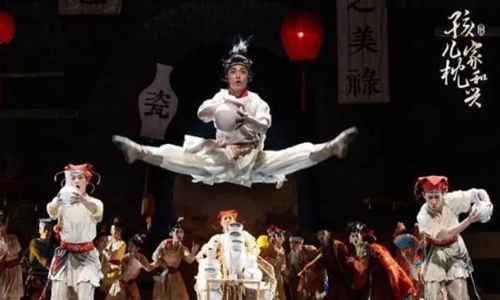
Promotional material Photo: Courtesy of the China Oriental Performing Arts Group
A modern dance performance inspired by a Song Dynasty (960-1279) artifact, a ceramic pillow shaped like a young boy, recently debuted in Baoding, North China's Hebei Province.
In the show, the boy-shaped ceramic pillow is personified by a dancer. Using the character as a narrative fulcrum, the show elaborates on stories such as a romance between ceramic craftsman Qu Sanjie and the heroine Xie Baihua. The performance is a successful example of a "traditional Chinese cultural IP interpreted with creativity," creative industry expert Yao Yu told the Global Times.
With an incredibly well-designed stage that shows the Song Dynasty's signature kilns and busy alleys filled with carriages, the dance performance not only explores the era's ceramic traditions, but also reveals the cultural-social landscapes of the period. Music-wise, it incorporated highly localized elements such as tunes from Hebei bangzi and Yangge, opera and music forms unique to the area's folk culture.
Historian Fang Gang told the Global Times that "the cultural tastes of the Song Dynasty were rooted in the era's folk traditions."
People's ordinary life activities and folk stories heavily inspired the art of the Song period including its ceramics as well as paintings such as the notable painting Along the River During the Qingming Festival.
A part of the Palace Museum's permanent collection, the boy-shaped porcelain pillow is the most iconic work of Hebei Province's Ding Kiln. Covered in genteel ivory white glaze, the pillow depicts a vividly sculpted boy reclining faced down so that the natural curve of his back can act as a pillow by supporting a person's neck.
Qiu Xiaoxi, an ancient ceramic researcher, told the Global Times that the products from the Ding Kiln, especially its impurity-free white glaze, reveals that by the Song Dynasty, ceramic craftsmanship in China was already "incredibly mature" as pure white coloring demands even more refined techniques than making green celadon wares.
Qiu also told the Global Times that the pillow is important as it conveys the "humanistic spirit and ancient lifestyles of the Song Dynasty."
"The white glaze symbolizes nobility and the understated aesthetics that were seen as elegant by ancient Chinese people. Also, the ceramic pillow shows ancient Chinese people's versatility with the material. Ceramics were truly part of Chinese people's lives," Qiu emphasized.
Baoding was chosen for the show's debut as the Ding Kiln was located in the city.
Jing Xiaoyong, Party chief and chairman of the China Oriental Performing Arts Group (COPAG), the show's main organizer, told the Global Times that there was a year-long incubation phase prior to the show's debut that included the creative team visiting Quyang county.
"The realistic style of the show interprets Chinese people's ethical tradition and portrays their real lives," Jing told the Global Times. He has also emphasized that COPAG has always been looking for creative ways to interpret traditional Chinese culture.
In 2021, COPAG's poetry dance performance A Mere Touch of Green became a phenomenon. Featuring choreography based on the Northern Song Dynasty (960-1127) silk scroll painting A Thousand Li of Rivers and Mountains, the show has held more than 500 performances nationwide since its debut in 2021.
"It is our important job to explain and introduce more excellent cultural works with Chinese characteristics, embodying the Chinese spirit and containing Chinese wisdom to the world," Jing emphasized.



